AudioQuest Niagara 3000
AudioQuest Niagara 3000 AC power conditioner
![]()
POWERLINE ACCESSORY REVIEWS
AudioQuest Niagara 3000 AC power conditioner
Tom Gibbs | Dec 11, 2020
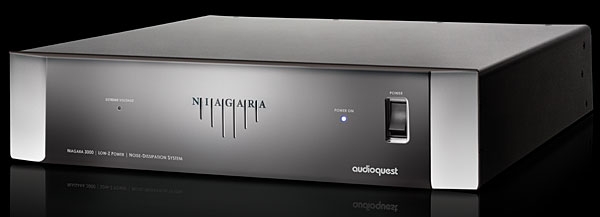
It stands to reason that any audiophile system would benefit from improved AC power. The rooms in most older homes are equipped with a single duplex receptacle on each wall, maybe two per wall in homes employing more modern construction practices. Behind the wall you're likely to find standard 14-gauge Romex, passing through via receptacles that typically sell for about a buck each. The electrical work meets local code, but audiophiles aren't involved in setting local electrical codes.
Another, newer problem is the proliferation of cheap electronic devices. Computers, computer components, and other electrical stuff is mostly powered by noisy switching power supplies; that noise can find its way back into electrical circuits. So can high-frequency hash coming from wireless routers. And ubiquitous power supplies, which charge their capacitors only above a certain voltage, cause those precious sinewaves to be lopped off at the peaks.
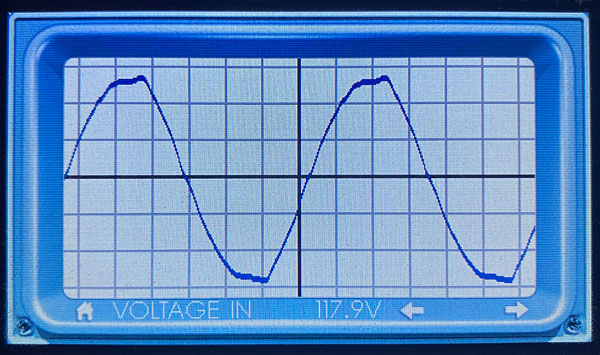
An example of an only moderately bad 60Hz sinewave, courtesy of 50-cent receptacles and 14-gauge Romex.
Audiophile-level systems require power for amplifiers, line and phono preamplifiers, multiple digital and analog sources, ancillary equipment, and perhaps a powered subwoofer or two. Sure, most electrical circuits are designed to filter noise and reject powerline distortions—but still, do you really want to connect all that gloriousness to a length of Romex of questionable origin, terminated with a 50-cent builder-grade receptacle, besieged with noise from inside and out? Exotic power conditioning units, which are intended to deal with at least some of those issues, are de rigueur in cost-no-object audiophile systems and come equipped with a multitude of high-quality power receptacles.
After living for 30 years in a modest home employing code-minimum electrical wiring, I built a new home 4 years ago and became seriously engaged in all aspects of my new home's construction. Before I got started, I'd stumbled across a Stereophile article by John Atkinson that extolled the virtues of having a pair of dedicated AC lines with hospital-grade electrical receptacles installed in his home listening environment;1 I wanted to have that in my new digs. But would my relatively modest system benefit from an expensive AC power conditioner?
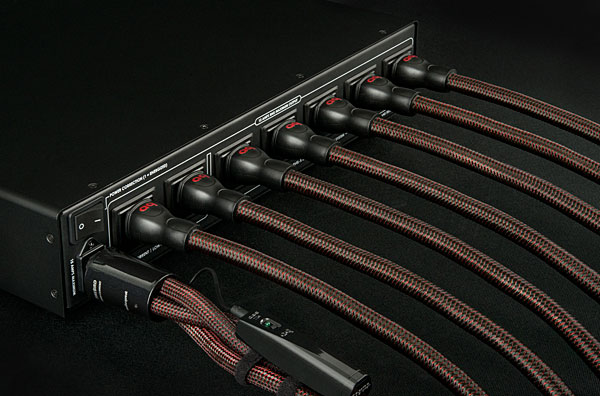
Recently, I was talking with Stephen Mejias of AudioQuest—formerly of Stereophile—about my review of the Bel Canto e1X stereo power amplifier. I mentioned that the manufacturer had expressed a preference for AudioQuest power conditioning and AC cabling absent that, they preferred for the amp to be connected directly to the wall receptacle, which is how I auditioned the amp. Mejias offered to send the Niagara 3000 Low-Z Power Noise-Dissipation System ($2995) for review. AQ also sent along a pair of NRG Edison AC power receptacles and a selection of mid-tier AC cables for attaching my equipment stack.
Setup
I've installed a number of electrical receptacles, switches, and lighting fixtures over the years, but never in a setup that incorporated 10-gauge wiring, which is stiff, thick, and unforgiving. Installing the NRG receptacles was hard work (footnote 1).
A couple of years ago, I had a conversation with Gordon Rankin, the first person to apply asynchronous USB, the technology currently used in most USB DACs, to audio. Rankin designed AudioQuest's DragonFly series and has his own line of audio electronics under the Wavelength banner. I told him I was thrilled to finally have separate, dedicated AC lines for amplification and source equipment. He told me that my enthusiasm was misplaced and my approach, flawed: All system equipment should be connected to the same dedicated line to prevent ground loops. So, the two 15-amp NRG Edison receptacles were installed on the same dedicated 20-amp line.
Upon completion of the installation, the Niagara 3000 was connected to one of the receptacles with an AQ Blizzard AC cable; my source equipment and amps were then connected to the 3000. The dual subwoofers were plugged directly into the two Edison receptacles—although Mejias told me later that the two subs should instead be connected to the furthermost two receptacles on the 3000's bank of five receptacles intended for sources.
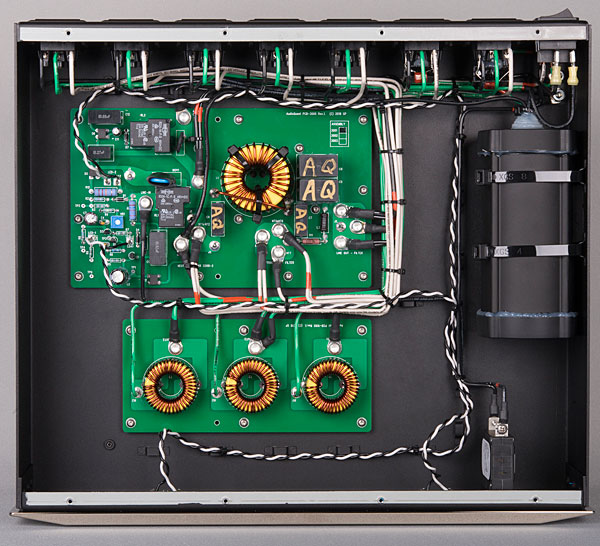
Design
AudioQuest states in their Niagara product literature that up to a third of a high-resolution, low-level audio signal can be masked, lost, or seriously distorted by poor-quality AC power—which is surely true as long as you're free to define "low-level" appropriately. The Niagara series has been designed to not only eliminate AC power noise but also to enhance the delivery of unhindered current to electronics. The Niagara 3000 is the base model in the line that features AQ's Transient Power Correction, which provides a current reservoir specified to provide more than 55 amps of "instantaneous" peak current. It also claims reduced line impedance for current-hungry power amplifiers.
The 3000 also features AQ's Ground-Noise Dissipation System, a patented technology that claims to reduce ground-borne noise without compromising safety or creating ground loops. AQ's Level-X Linear Noise-Dissipation Technology is said to ensure consistent, wide-bandwidth noise dissipation. The NRG Series AC power inlets and receptacle used on the 3000 are said to utilize both high-purity red copper and beryllium copper; beryllium copper is used in springs and other applications where shape-retention under repeated use is required. Connecting surfaces are coated with a thick layer of silver. AQ's Niagara Series offers nonsacrificial surge protection, which can protect equipment from power surges or spikes up to 6000 volts or 3000 amps without sustaining damage.
The Niagara 3000 is designed for shelf-, floor-, or rack-mounting; rack-mount hardware is included in the box. It has only two switches: a power switch on the front panel and another switch on the back panel that controls the activation of the Transient Power Correction Circuit. The default position for this switch is "energized"; otherwise, any connected power amplifiers won't be getting the full benefit of the circuitry. The supplied manual describes connection scenarios where it might be beneficial to disengage this switch, but those situations seem rare.
Footnote 1: Apologies in advance for the boring, obligatory disclaimer, but seriously, do not attempt your own electrical alterations without understanding the risks and being sure you have the skills. Household electrical power can kill you and burn your house down. Plus, a job like this can be performed quite affordably, probably much faster, and certainly more safely, by a professional electrician.—Editor
The unit has seven rear-panel AC receptacles. Receptacles 1 and 2 are the High Current/Low-Z receptacles intended for power amplifiers; they employ AQ's Transient Power Correction. The remaining five receptacles, for sources, employ AQ's Level-X Linear Noise-Dissipation System; all five source receptacles are isolated from the two high-current receptacles and are broken into two banks, 3–5 and 6–7, which are also isolated from each other. These receptacles are principally intended for connection of source equipment; the manual offers some connection guidelines, but also recommends experimentation to determine which connection scheme yields the best-sounding results. All Niagara units are shipped without power cords.
Early in the review process, I had questions with respect to not only the Niagara 3000 but also AQ's AC power design philosophy and implementation, in general. Garth Powell, AQ's senior director of engineering and designer of power products, answered my questions.
"The NEMA Edison duplex receptacle is a 'grandfathered' design that's nearly a century old. It was meant for 110VAC at 10 amps. [The standard is] now 120VAC at 20A, and all that's changed is mostly cosmetic. The brass material is soft and thin; it was made for marginal safety concerns and to be inexpensive. In an audiophile system, we have special tools to tighten our speaker cables to the binding posts, and RCA or balanced XLR connectors feature a vice-like grip. Yet the poorest connector in the system is the one that carries the most RMS (average) current, transient current, and AC voltage?

"At AudioQuest, we reverse-engineered every premium-audiophile power receptacle we could find. Some were substantially better than average (a few [were] actually worse), but what I saw too often was cryogenic freezing, or rhodium plating over a mostly stock design that simply wasn't up to par. I decided to not only use beryllium copper base metal for its high spring strength, but all metal parts are up to 40% thicker than a typical NEMA or hospital grade AC receptacle. The only plating is thick, direct silver using what's called the 'hanging' plating process. This assures that induced radio-frequency noise has a low-impedance path back to the electrical panel and Earth ground. Further, it's low-impedance at radio frequencies. The plating covers all modes: Line, Neutral, and Ground. Many premium power receptacles do not. For audio-video performance, details count. Noise-dissipation is a drainage system, and we do not want a power receptacle to interfere with the drain path back to earth. Additionally, a typical power amplifier can require instantaneous transient current as high as 70 amps peak. The lower the impedance of the wall connection, the better the delivery of the transient current. [There's] less current compression."
Listening with the Bel Canto e1X
The Bel Canto e1X was reinserted into my system and connected to the Niagara 3000 with an AudioQuest Blizzard AC cable. "Song of the Stars," from the Dead Can Dance album Spiritchaser (16/44.1 FLAC, 4AD 46230), was playing; something very quickly got my attention: The dual subs seemed to be playing at a lower-than-usual volume. After adjusting the volume of the subs upward to match the rest of the system, I noticed that the bass content was all there, just none of the distortion that often accompanies it. With the dual subs connected to the Niagara 3000, it was obvious that there was less distortion in the signal, and the bass was deeper, more dynamic, and more musical than before.
The e1X is a superb class-D amplifier; I've never found its performance lacking. Designer John Stronczer says his power supply design allows the e1X to avoid the sort of midrange distortions that seem to plague many class A/B amps with large toroidal transformers. The e1X—even when connected directly to my existing AC line—presented music that was almost Technicolor in comparison to my Emotiva XPA-1Ls. During the Dead Can Dance session, it became apparent that the bass content wasn't the only story; Brendan Perry's deep baritone never sounded so resounding, and his guitar tone was articulate and rounded. Later in the song, when Lisa Gerrard's otherworldly voice joined in a call and response with Perry, the effect was mesmerizing.
The new playback chain that now included the Niagara 3000 and the NRG Edison receptacles allowed my system to extract a previously unheard level of tangibility from the streamed recording. I also listened to the tune "Don't Let It Bring You Down" from Neil Young's Live at Massey Hall (16/44.1 FLAC, Reprise 9362-43328-2); I was taken aback by the vividness of Neil Young alone with his guitar. The real eye-opener, however, was when the music stopped: The absolute quiet in my room was almost ghostly compared to the state I was accustomed to.
Additional listening
The Emotiva XPA-1L monoblocks have been part of my system for some time now; their sound has always impressed me as being both neutral and dynamic. After the appearance of the Bel Canto e1X, however, I was almost ready to consign them to the scrap heap. Their presentation seemed "colorless" in comparison with the e1X, which was confirmed by repeat listens in the aftermath of the e1X review.
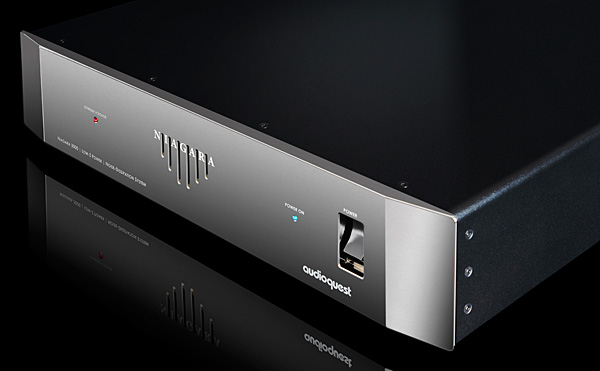
Upon connecting the XPA-1L's to the Niagara 3000, I was struck by an improved level of clarity and authority and perhaps a touch of previously unheard sweetness; listening through them suddenly became a more engaging musical experience. I'd been using recent SACD acquisition, the Shostakovich Symphonies Nos. 1 and 15 (SACD, BIS 7318599916439) with Mark Wigglesworth and the Netherlands RPO, as a demo disc for friends with the Bel Canto e1X and the Maggie LRS loudspeakers. With the Niagara 3000 in place, it was now possible to experience the delicacies and dynamics of this music to a degree previously unheard.
I played a few LPs with the PrimaLuna EVO 300 integrated amp connected to the Zu Omens, among them, the new Craft Recordings vinyl reissue of Collective Soul's eponymous second album (Craft Recordings CR00290). The opening track, "Simple," is powerful and dynamic, easily the best song on the album. With the Niagara 3000 in the loop, analog playback was the best I'd ever heard here. Even though the Musical Surroundings Phonomena II+ phono pre has a dedicated linear power supply, plugging it into one of the 3000's source receptacles vanquished the touch of electronic haze that normally appeared in my system around the midpoint of the volume dial. That haze is now gone, at all volume levels.
Conclusion
It's obvious to me now that clean AC power is necessary to allow audiophile-grade equipment to perform as designed; otherwise, even the best products will fail to fulfill their potential. In combination with the Niagara 3000, the Edison receptacles and upgraded AC power cables enhanced the performance of all my system components. AudioQuest and Garth Powell had already managed that with the more advanced and expensive components in the Niagara Series; now the reasonably priced Niagara 3000 places that goodness within reach of more people.
Sidebar 1: Specifications
Description: AC powerline conditioner with seven receptacles.
Dimensions: 17.5" (445mm) W × 3.45" (88mm) H × 15.2" (386mm) D. Weight: 24.9lb (11.3kg) net, 33lb (15kg) shipping.







